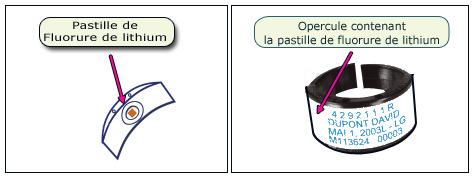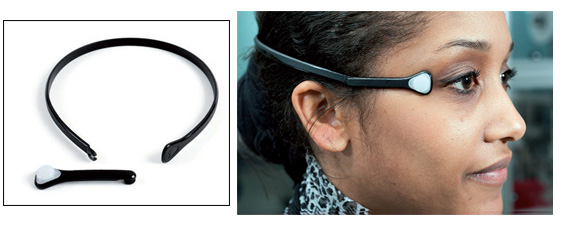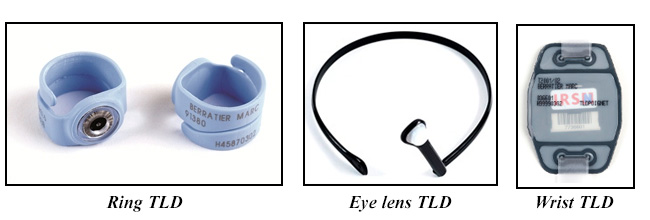Exploit thermoluminescence for dosimetry
The energy provided by ionizing radiation may cause defects in the structure of crystalline structure materials. When the material is later heated, the thermal agitation progressively these defects and restore the crystalline structure. During these “repairs”, there are emissions of light : it is the phenomenon of thermoluminescence. The quantity of light restored, under given conditions, is proportional to the dose received.
The recording of the light emitted provides a measure of the dose. Dosimeters that exploit this phenomenon are called thermoluminescent dosimeters or TLDs.
These TLD dosimeters are widely used because thermoluminescent materials can be adapted to the sensitivity required for an intended use, making their use fairly flexible: they are used both in individual dosimeters and for monitoring areas or environment studies.
The detection element may have small dimensions, which makes it possible to use this technique to make extremity dosimetry (dosimetric ring) or eye lens (IRSN DOSIRIS dosimeter).

Thermoluminescent rings
These ring-dosimeters operate according to the thermoluminescence principles. They are intended to accurately measure the equivalent doses received by the extremities particularly exposed to ionizing radiation. The detector consists of a lithium fluoride pellet placed in a cavity closed by a heat-sealed lid. When read by heating, the pellet emits a luminescence proportional to the exposure to radiation. The reading reset the detector.
© LCIE Landauer
Some occupational activities present the risk of exposure of the lens to radiation. This is the case, for instance, of interventional radiology, which poses risks for operators and surgeons who are exposed to the radiation produced by the instruments because of interventions that may be long, the proximity of the rays and the repetition of examinations or operations.
The indication provided by the standard dosimeter placed on the chest is no longer sufficient. It must be completed by an eye lens dosimeters. DOSIRIS, such a dosimeter developed by the IRSN, is the solution to carry out this monitoring under the best conditions. In France, there are approximately 3,000 Dosiris carriers (eye lens dosimeters), for example in the field of cardiac surgery in interventional radiology and nuclear medicine, and maintenance operations in the nuclear industry such as glove box handling.

DOSIRIS dosimeter
This dosimeter can be worn on the left or right side. It is positioned on the side of the most exposed eye to radiation by means of a headband and its articulated arm to obtain the best dosimetry possible. The best position is obtained when the detection part (white capsule) is placed closer to the corner of the eye, against the temple and under the glasses, visor or protective mask.
© IRSN
The wrist dosimeter is a complementary dosimeter intended for measuring the exposure of the extremities to ionizing X rays, gamma and beta radiations. Its wearing is strongly recommended especially when the forearms are in the immediate vicinity of radioactive sources or close to beams of irradiatiing particles. It ensures that exposure limits of the skin and extremities are not exceeded. It is suitable for dosimetric monitoring in the medical, industrial and research fields.

TLD dosimeters
Example of three TLD dosimeters proposed by the IRSN for monitoring the exposure of fingers, lens and extremities such as wrists.
© IRSN
Advantage of thermoluminescents dosimeters :
– Their energy response is fairly linear, that is to say that the amount of collected light is proportional to the dose, which facilitates the reading of the dosimeter ;
– Interposing screens, one can extend this sensitivity; some materials have a density cole to densities of living tissues . This allows a good estimate of the effective dose;
– They offer a large dynamic range, that is, they are sensitive to both low and high doses. They can measure doses of the order of a millisievert (mSv), and provide reliable orders of magnitude for doses corresponding to criticity accidents (beyond the Sv);
– Once calibrated, they allow automated readings ;
– Their reading resets them; they are reusable up to several hundred times.
– They are very robust, insensitive to moisture or shocks ; Some variants are also sensitive to neutrons.
Among the disadvantages :
– They can only be read once, unlike RPL or OSL dosimeters;
– Their storage before use requires placing them in lead castles, to avoid the background of cosmic rays radiations. (It is this same background that allows the use of thermoluminescence for the dating of heated archaeological objects or lava).
Other articles on the subject « Dosimetry »
Passive Dosimeters
Portable dosimeters for monitoring of exposed people Dosimeters called passive are dosimeters tha[...]
OSL Dosimeters
Dosimetry by “Optically stimulated luminescence” The active element of an OSL [...]
RPL Dosimeters
Sensitive, robust and widely used dosimeters These passive dosimeters use radiophotoluminescence [...]
Active Dosimeters
For real-time monitoring of workers exposed to radiation Active dosimeters are in fact ele[...]